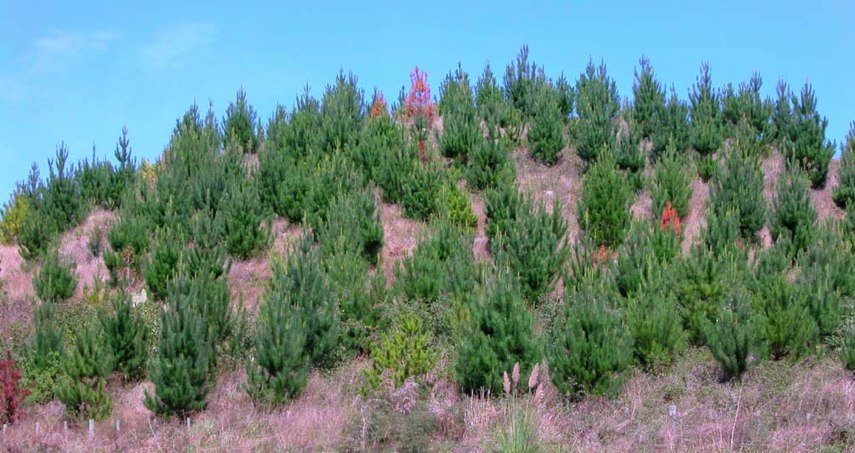PESTS AND DISEASES OF FORESTRY IN NEW ZEALAND
Junghuhnia spreads by spores
Scion is the leading provider of forest-related knowledge in New Zealand
Formerly known as the Forest Research Institute, Scion has been a leader in research relating to forest health for over 50 years. The Rotorua-based Crown Research Institute continues to provide science that will protect all forests from damage caused by insect pests, pathogens and weeds. The information presented below arises from these research activities.
From Forest Health News 198, September 2009.
Earlier this year dead and dying trees were noticed scattered throughout a young stand of Pinus radiata. The affected site was on the coastal lowlands in the Bay of Plenty region.
It was initially assumed that the cause of the mortality was armillaria root disease, but closer inspection failed to reveal any of the characteristic signs of infection (mycelial fans and rhizomorphs). A number of the affected trees were sampled, and isolations from the roots and root collar zone all yielded cultures of the basidiomycete fungus Junghuhnia vincta (synonyms, Poria vincta, Rigidoporus vinctus).

Identification was confirmed by the presence of two fructifications in different stages of development, each situated just above soil level at the base of an infected tree.
J. vincta is well known as a root disease pathogen in New Zealand (see Forest Pathology in New Zealand 18) and in other parts of the world, more so in the tropics and sub-tropics. It is noteworthy that records in this country often, but not exclusively, come from warmer sites in the northern half of the North Island.
The disease appears relatively unimportant, being encountered infrequently, and with deaths occurring only singly or in small groups. Nevertheless, a variety of tree and shrub hosts are attacked in forest plantations, shelterbelts, ornamental plantings and home gardens.
In pine plantations J. vincta was first recognised as a minor problem in the coastal Bay of Plenty region in the 1980s, and it has since been found at other locations. Symptoms in young pine trees are superficially similar to those in trees infected by Armillaria species, but foliage discoloration and death tend to be irregularly distributed across the crown and even within the same branches. Longitudinal sunken grooves or depressions may be present running part way up the stem from the root collar.
J. vincta occurs naturally as a decomposer of woody debris within native forests.
The affected pine stand observed earlier this year had replaced a plantation of Eucalyptus nitens which was, itself, established on a site that had previously been farmland, devoid of woody material. This suggested that J. vincta had colonised the E. nitens stumps by means of basidiospores, from which it had then grown vegetatively along the roots to infect the young pine trees.
Spores are believed to be important for the spread of J. vincta in plantations of Araucaria cunninghamii (hoop pine) in Queensland (L. Bolland, pers. comm.). To test this idea, an isolate of J. vincta was cultured from each of 10 diseased trees distributed over an area 500-600 m across in the young radiata pine stand. The 10 isolates were then paired on agar growth medium in the laboratory in all possible combinations.
With one exception, all pairings produced a barrier zone of incompatibility where the two expanding cultures met, indicating that the isolate from each tree was genetically different from those in the other trees. However, the isolates from two trees merged evenly without forming a barrier zone, signifying that they may have originated as identical mycelia from the same spore source. These two trees were situated near each other and it is possible that each had become infected by mycelium growing from within the same eucalypt stump. When self-paired, cultures also all merged uniformly, and the same result occurred in pairings of two isolates from a single tree, one taken from the mycelium of a fruitbody present at the base.
These results support the view that numerous, small, root disease centres become established by means of basidiospores that disperse from fruitbodies of J. vincta produced naturally in nearby reserves of indigenous forest. Indirect evidence indicates that Armillaria novaezelandiae also spreads and sets up new infection centres by means of basidiospores (see Forest Health News 142:1 2004). Why, then, were the trees examined in this stand only infected by J. vincta?
It may be that J. vincta has a propensity to release spores more prolifically over longer periods that possibly differ from those of A. novae-zelandiae, which disperses its spores mainly during winter (May and June). It is believed that the previous E. nitens stand was felled during summer, so that by the time the stumps were exposed to spores of A. novae-zelandiae, they would have already been well colonised by other wood decay fungi, including presumably J. vincta. Perhaps stumps of E. nitens also provide a particularly suitable substrate for spore colonisation?
These suggestions provide a plausible explanation for what was observed in the field, but are nevertheless merely conjectural. Verification awaits a full study of the spore-release and dispersal periodicity of J. vincta.
Ian Hood
This information is intended for general interest only. It is not intended to be a substitute for specific specialist advice on any matter and should not be relied on for that purpose. Scion will not be liable for any direct, indirect, incidental, special, consequential or exemplary damages, loss of profits, or any other intangible losses that result from using the information provided on this site.
(Scion is the trading name of the New Zealand Forest Research Institute Limited.)

 Farm Forestry New Zealand
Farm Forestry New Zealand

